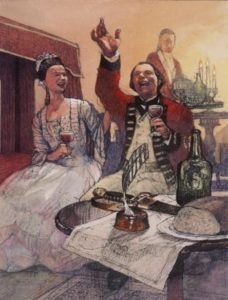Andebit et beaqui corendit, ut quostes esciendion re dit ad et prae parion es quia quas alibus sam, omnim faciden ducipidiat arum autem nobis enis es voat

18. Fort Ann Pocket Park: Burgoyne Celebrates
The British were feeling pretty confident in how the war was proceeding. Were they getting too cocky?

British General John Burgoyne was delighted. He had anticipated that it would take him months to unseat the Rebels from their entrenched position at Fort Ticonderoga, but by mid-July, the Rebels were on the run and Burgoyne was advancing toward the Hudson River. He felt it was time to celebrate. In Skenesborough, Burgoyne hosted a banquet where he raised a feu de joie—French for “a cry of joy,” a feast in celebration of their recent successes.
His rapid advance did have an unintended consequence. It altered Burgoyne’s planned route to get to Albany via the Hudson River. Rather than traveling by way of Lake George, he would be traveling mainly by land south of Whitehall. Burgoyne was aware of the challenge of crossing through the woods and marshy lowlands between Skenesborough (Whitehall) and Fort Edward. The passage was narrow and boggy. Nevertheless, he determined that his troops would continue on their path to Fort Edward using this land route. The supplies would go by Lake George as planned.
Colonel Philip Skene likely played a role in Burgoyne’s decision. As a major landowner and businessman, Skene was familiar with the area surrounding Whitehall and believed there were Loyalists living in the area that could help fill Burgoyne’s ranks and supply his army.
Baron Frederich Riedesel was ordered by Burgoyne to remain in the vicinity of Hubbardton, Vermont, to protect the Loyalists. Guards were placed in front of their homes to protect them from the Rebels. When a Rebel was discovered, they were imprisoned and would eventually face a military execution.
Travel Tools
Fort Ann (formerly spelled Anne) played a vital role in the Wilderness Wars and the French and Indian War. No less than five fortifications were constructed here between 1690 and 1777. They were constructed, destroyed, and reconstructed during the conflicts to prevent it from falling into enemy hands.
A replica blockhouse now sits at the north end of the village. The community constructed the blockhouse as a part of the museum in 1954. It is now home to Glens Falls National Bank. Learn more about the old museum and Battle Hill by visiting the Old Stone House Library.
Start Track 18 as you enter Fort Ann and pull into the Pocket Park on the right to finish listening.
CLICK TO VIEW SITE NINETEEN
First-Hand Accounts
Rebel losses were heavy:
“I have the honor to inform your Lordship, that the enemy, dislodged from Ticonderoga and Mount Independent, on the 6th instant, and were driven, on the same day, beyond Skenesborough on the right, and to Hubbardton on the left, with the loss of 128 pieces of cannon, all their armed vessels and bateaux, the greatest part of their baggage and ammunition, provisions, and military stores, to a very large amount have been captured.”—General John Burgoyne
On advice from Colonel Skene, Burgoyne believed colonists in the Hampshire Grants would supply the army and help fill his regiments of Loyalist militia. He wanted Riedesel was to act as a liberating force, protecting the inhabitants and punishing the treasonous Rebels:
“After taking up this position, I desire you to use all means to encourage the inhabitants. You will offer them the protection of the king by placing sentinels in front of the houses and possessions of those who are known to be loyal, and by saving those houses which are empty until you receive further instructions, as I intend to appoint a certain time for the guilty ones to return, before resorting to military executions. I would also request you to punish soldiers or others under your command, who may be found guilty of plundering or otherwise abusing the inhabitants.”—General Burgoyne to Baron Riedesel, July 10, 1777


